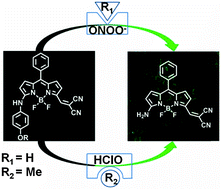Transforming the recognition site of 4-hydroxyaniline into 4-methoxyaniline grafted onto a BODIPY core switches the selective detection of peroxynitrite to hypochlorous acid†
Abstract
Two novel probes were designed, sharing the same BODIPY core but differing only by a minimized variation in the recognition site from 4-hydroxyaniline into 4-methoxyaniline. Such a small change in the reaction site could switch the selective detection from peroxynitrite to HOCl. Undoubtedly, the new designed BODIPY core exhibits valuable properties.


 Please wait while we load your content...
Please wait while we load your content...